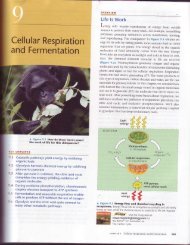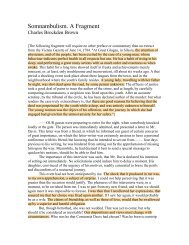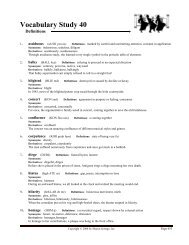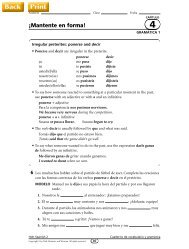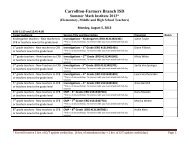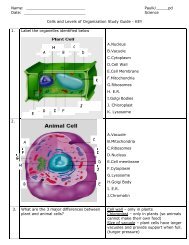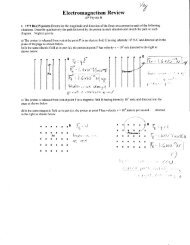Pt Two
Pt Two
Pt Two
Create successful ePaper yourself
Turn your PDF publications into a flip-book with our unique Google optimized e-Paper software.
UNIT NINE: Late Baroque and Rococo STUDY GUIDE<br />
K Elisabeth Vigée-Lebrun. Marie Antoinette and her Children, 1787, oil on canvas<br />
Elisabeth Vigée-Lebrun/ Marie Antoinette/ emphasis on / motherhood/ Rococo love of sentiment<br />
1. Elisabeth Vigée-Lebrun (1755-1842) “painted several portraits of Marie Antoinette, the Austrian-born<br />
queen of Louis XVI… Vigée-Lebrun befriended monarchs and their families, and benefited from their<br />
patronage. Her 1788 portrait of Marie Antoinette and her Children depicts the Queen of France in an elegant,<br />
regal setting, oblivious to the social, political, and economic unrest among her subjects that would erupt the<br />
following year and culminate in the French Revolution. The variety of rich textures- silks, laces, and brocades,<br />
and Marie Antoinette‟s enormous feathered hat- emphasize the wealth and position of the sitters. At the same<br />
time, the Queen shows her ease with motherhood. One daughter nestles against her shoulder and the toddler<br />
squirms on her lap. The boy introduces a somber note as he pulls aside the crib cover to reveal the empty<br />
bed, denoting the death of one of Marie Antoinette‟s children” (Adams, Art Across Time 684). “In 1783, Vigée-<br />
Lebrun was elected to one of the four places in the French Academy available to women. As the favorite<br />
painter to the queen, Vigée-Lebrun escaped from Paris with her daughter on the eve of the Revolution of 1789<br />
and fled to Rome. After a very successful self-exile working in Italy, Austria, Russia, and England, the artist<br />
finally resettled in Paris in 1804 at the invitation of Napoleon I and again became popular with Parisian art<br />
patrons. Over her long career, she painted around 800 portraits in a vibrant style that changed very little over<br />
the decades” (Stokstad, Art History 935).<br />
2. “Her portrait of Marie-Antoinette en chemise raised a few eyebrows at the Salon in 1783; indeed, under pressure she withdrew the<br />
painting from the exhibition. Because this expensive, casual clothing- known as a chemise en robe- was associated by many with lingerie,<br />
the artist was perceived as having broken rules of decorum. But we know that the Queen loved this relaxed, even intimate, portrait of<br />
herself. With the cult of sensibility has done, perhaps without either the Queen or her artist being very conscious of the fact, was to<br />
undermine, or compromise, the power of the monarchical portrait” (Minor 232). “Vigee-Lebrun did not cast her subjects as goddesses, but<br />
she imparted to them a chic sweetness and artless simplicity. These talents earned her the equivalent of over $200,000 a year and<br />
allowed her an independence uncommon among eighteenth-century women” (Fiero, Faith, Reason, and Power 145).<br />
L Jean-Simeon Chardin. Grace at Table, 1740, oil on canvas<br />
Jean-Simeon Chardin/ environment free of corrupt society/ discarded toys vs. properly set table/ art of<br />
instruction and moral uplift in a middle class home<br />
1. “The son of a furniture maker, Jean-Baptiste-Simeon Chardin (1699-1779) probably originally intended to<br />
work in his father‟s trade. In 1718, however, he was apprenticed to a painter, and being quite gifted, soon<br />
acquired the basics of this craft. At age twenty-eight he presented two paintings to the Royal Academy hoping<br />
to gain admission. The academicians were so dazzled by these works- especially The Ray Fish, which<br />
represents an enormous, glistening, disemboweled ray fish suspended from a hook and a cat tiptoeing toward<br />
the foreground over open oysters- that Chardin was immediately accepted as a full member” (Govignon 195).<br />
“Chardin specialized first in small still lifes of kitchen utensils and food laid out for the cook. Around 1733 he<br />
began to paint genre subjects- scenes from everyday life- starting with the charming Lady Sealing a Letter,<br />
hoping to widen his repertory and win new clients. Thereafter he produced many such scenes showing, for<br />
example, maids doing the laundry or a governess helping children dress for school. His paintings of children<br />
are especially poetic, showing them as rather grave young adults, completely absorbed in their games” (195).<br />
2. “A gentle sentiment prevails in all of his pictures, an emotion not contrived and artificial but born of the<br />
painter‟s honesty, insight, and sympathy. (It is interesting that this picture was owned by King Louis XV, the<br />
royal personification of the Rococo in his life and tastes.)” (Kleiner, Mamiya, and Tansey 842). “Everyone knows the story-or legend?- of<br />
how he was prodded into painting human forms. One day he heard his friend Aved refuse a commission of four hundred livres to paint a<br />
portrait; Chardin, accustomed to small fees, marveled at the refusal; Avel answered, „You think a portrait is as easy to paint as a<br />
sausage?‟ It was a cruel jibe, but useful; Chardin had confined his subjects too narrowly, and would soon have satiated his clients with<br />
dishes and food. He resolved to paint figures, and discovered in himself a genius of sympathetic portrayal that he had allowed to sleep”<br />
(Durant, Age of Voltaire 318).<br />
3. “In Saying Grace (at the Salon it was called Bénédicité, which is the first word of Grace, from the Latin benedicite), a mother pauses in<br />
the process of ladling out the meal of her two young children, as the smaller of these falters over the simple prayer, glancing up to her for<br />
assistance. His sister looks on, not without malice, at his difficulty. The legend on Lepicie‟s engraving of 1744 suggests that the little boy<br />
is garbling his prayer as fast as possible, because his mind is more on his food. Again the setting is a simple bourgeois, living-room,<br />
comfortable with its damask tablecloth and a pair of good upholstered chairs; the brazier at the right „answers‟ the pug and work-box in<br />
the companion picture” The Industrious Mother (Conisbee 162-163). “Although he was unsurpassed as a still-life painter, he always<br />
regretted that his father lacked the means to provide him with a humanistic education and therefore prepare him for history painting, the<br />
most prestigious of all forms of art in the Baroque and Rococo periods” (Minor 252). “The values of simplicity, truth, and naturalness were<br />
much promoted in the seventeenth and eighteenth centuries as an antidote to the corruption of the court and the city. The disasters of<br />
the final years of Louis XIV‟s reign, followed shortly by a catastrophic stock market crash in Paris in 1720, encouraged many to seek<br />
modest values and personal virtue. The work ethic promoted by the middle class went hand in hand with a strong attachment to family<br />
and the pursuit of prosperity” (262-263).<br />
26



